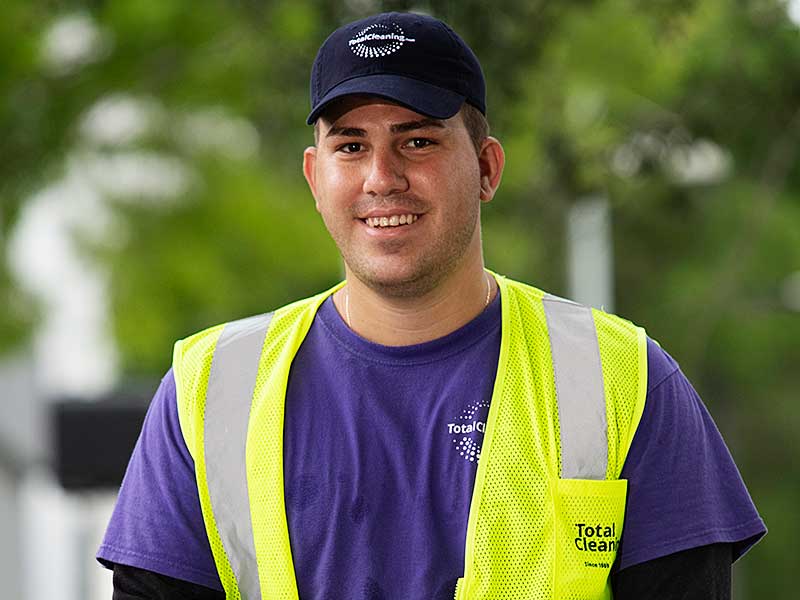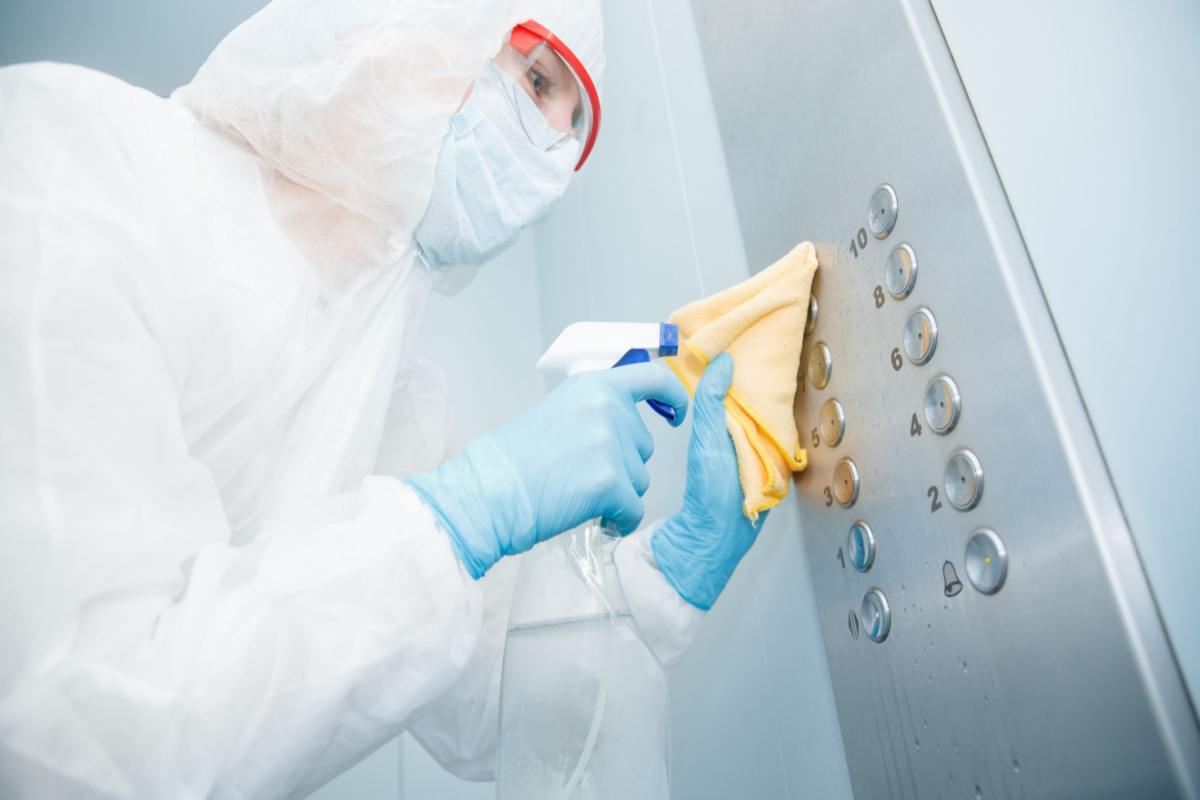When it comes to effective hygiene management, parsing words is critical. The terms cleaning, sanitizing, and disinfecting seem interchangeable in conversation, but in practice, understanding their differences is essential to protect people, buildings, and businesses from pathogenic threats. Unfortunately, not all janitorial teams have the proper processes, leaving businesses, medical practices, and hospitals vulnerable to outbreaks, including bacterial infections, the common cold, and Covid-19.
Here we break down the differences between cleaning, sanitizing, and disinfecting so your people can feel safe and your business can thrive while your furniture shines.
Cleaning vs. Sanitizing vs. Disinfecting
Delineating between cleaning, sanitizing, and disinfecting is necessary for janitorial teams to do their jobs effectively. This is especially true amidst highly contagious Covid strains, flu season, and all-year-round viral and bacterial infections that cause health risks, excessive absenteeism, and reduced productivity.
So, let’s break it down:
What does cleaning really mean?
Essentially cleaning is what janitorial teams do to ensure floors, furniture, and windows shine to make a good impression on visitors, employees, and consumers. Cleaning products remove visible soil, dirt, and organic matter from surfaces, washing away cosmetic impurities along with harmful organisms. Like soap and detergents, many cleaning solutions remove most surface pathogens, but they’re typically not strong enough to make disease-fighting claims.
What does sanitizing mean??
Sanitizing lowers surface germs to a safe regulatory level, which helps reduce bacterial infections like food poisoning and strep throat. Compared to disinfectants, however, sanitizers are held to a much lower bar for EPA effectiveness and are not intended to kill fungi or viruses. That said, some antibacterial products are also EPA-registered disinfectants because they’ve been tested against and approved for both methods.
What does it mean to disinfect?
Disinfecting is the most effective method to lower the risk of infection and pathogen spread. The process kills bacteria and fungi while eliminating viruses much more efficiently than sanitizing or cleaning. According to ISSA, disinfecting provides a six-log reduction (99.9999%) in bacteria, while sanitizing only provides a three-log (99.9%) reduction.
Why it’s so important to know the difference
Understanding the difference between cleaning, sanitizing, and disinfecting is the first step to implementing a comprehensive office hygiene program.
Cleaning can be helpful in areas that people don’t often touch or in places that require gentler chemicals. But If your team focuses on cleaning only, they will miss frequently touched surfaces that carry and spread the most harmful pathogens.
Conversely, if inexperienced staff members skip cleaning and head straight to disinfecting or sanitizing, they’ll miss the critical first step that prepares surfaces for effective pathogen removal.
Cleaning Best Practices
Anytime a surface contains visible soil, it must be cleared and then cleaned to prime the area for disinfecting or sanitizing.
Here’s where the process gets a little convoluted for inexperienced janitorial teams.
Yes, cleaning is its own step, but cleaning chemicals aren’t necessarily unique to that process. Cleaning solutions can be as mild as soaps and detergents, or they can be EPA-approved disinfectants that kill germs and viruses as well. Regardless of the product at hand, technicians must apply the cleaning solution twice–first to wash away impurities and later to disinfect–to be effective.
However, the rules change slightly for surfaces that don’t contain visible dirt or debris. In these cases, janitorial staff can clean and disinfect simultaneously using one chemical solution. But the team must be careful only to utilize products that make this explicit one-step claim.
Sanitizing Best Practices
EPA-approved sanitizers reduce surface bacteria by 99.9% when used properly=. So the best sanitizing approach will depend on the type of surface and the public health standards for the particular industry. For example, restaurants and food preparation facilities have specific sanitizing requirements to prevent cross-contamination and food-borne illness, differing from school and office requirements.
In any case, basic sanitizing typically requires:
- Scraping the surfaces free from visible dirt, debris, or food.
- Cleaning the surface with hot soapy water
- Rinsing with clean water
- Cleaning the area with an EPA approved sanitizer or disinfectant
- Allowing the space to air dry fully
Like cleaning solutions, sanitizing products can double as disinfectants. But staff members should never take this 2-in-1 approach without reading the product label first. The label must explicitly say the solution can be used for both and provide individual usage instructions for each process. Typically, when using a disinfectant to sanitize, the process requires a different dilution and contact time.
But you may be wondering if disinfectants are more effective at killing viruses, and some double as antibacterial products, why sanitize when I can disinfect instead?
Sanitization methods are helpful for low-touch surfaces that don’t attract excessive bacteria and surfaces that may be safer without powerful chemicals such as cooking tools or children’s toys.
Disinfecting Best Practices
Conventional disinfecting sprays are potent tools for easy-to-reach surfaces. In fact, the CDC recommends that most facilities use manual disinfection solutions with approved chemicals over alternative methods due to safety risks from improper use.
But manual tactics can be time-consuming and inadequate for hard-to-reach areas. That’s why we use a combination of hand-spraying and mechanical electrostatic sprayers (ESS), which coat surfaces with charged liquid disinfectants. ESS devices help us combat SARS-CoV-2 in hotels, schools, airlines, stadiums, theaters, and hospitals because our team is well-trained to utilize them properly.
To effectively disinfect with electrostatic sprayers, users must distribute a thick enough layer to allow the product to remain wet on the surface for the time it needs to eliminate pathogens (as stated in the manufacturer’s instructions). Typically, technicians must spray a two-square meter area back and forth for at least 30 seconds to allow it to dwell for the average recommended time of five minutes.
After the contact period ends, cleaning staff must wipe the area for best results. The mechanical wiping action removes stubborn leftover organisms and the remaining disinfectant solution before it builds up on the surface. Product buildup, whether from electrostatic devices or manual sprayers, damages and discolors surfaces and make future disinfection more challenging.
Finally, janitorial teams must utilize the right chemicals with an electrostatic sprayer. Chemicals like chlorine bleach are hazardous because ESS devices produce tiny droplets that people can inhale. To be sure, facility managers must check the product label or work with an experienced commercial cleaning company like Total Cleaning to get the job done.
The Bottom Line
Unfortunately, it’s easy for janitorial teams to inadvertently cut corners because of confusion about proper cleaning, sanitizing, and disinfecting protocols. For example, the appearance of a shiny desk can trick people into thinking the surface is both clean and pathogen-free. But that confusion can put businesses at risk. That’s why it’s important for medical facilities, businesses, and schools to work with trained and experienced commercial cleaning companies that understand the nuances and deliver complete spectrum cleaning and disinfecting solutions.



